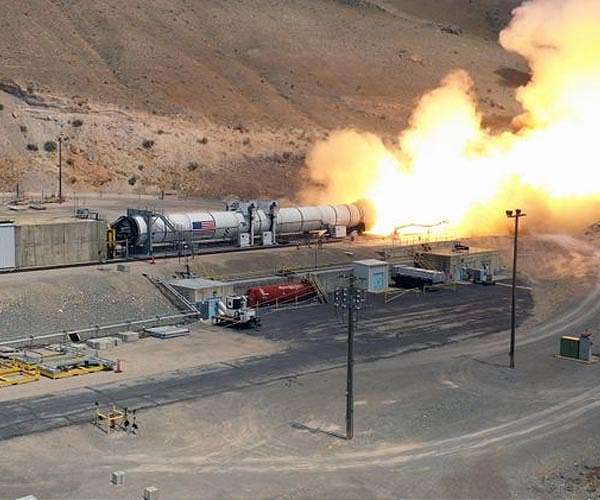
Northrop Grumman and NASA test SLS booster (Image Credit: Space Daily)
Northrop Grumman and NASA have conducted a full-scale static fire of NASA’s Space Launch System (SLS) rocket motor, known as Flight Support Booster-2. The five-segment solid rocket booster is the world’s largest solid rocket motor and will provide more than 75 percent of the SLS rocket’s initial thrust during launch.
Over 300 measurement channels assessed the 154-foot-long solid rocket booster as it fired for just over two minutes producing upwards of 3.6 million pounds of thrust. Today’s test evaluates new materials and demonstrates a new motor ignition system and an electronic thrust vector control system that steers the motors to provide data for the development of the next-generation Booster Obsolescence and Life Extension (BOLE) boosters.
Northrop Grumman was awarded a contract to develop the BOLE booster in December 2021. The award also included follow-on production and flight sets for Artemis IV through Artemis VIII, and a BOLE booster set for Artemis IX.
“Continuous product improvements and obsolescence mitigation helps NASA achieve its long-term mission to utilize SLS for its Artemis program,” said Wendy Williams, vice president, propulsion systems, Northrop Grumman. “This opportunity for early learning on next-generation systems will help us develop an enhanced booster that is ready to support the greater payload demands of the SLS rocket through 2031.”
Booster segments for Artemis II, the first crewed Artemis mission, and Artemis III, the mission that will land the first woman and first person of color on the lunar surface, are complete. Artemis IV segments are currently being cast with propellant and the first BOLE booster composite segment case to be used for development testing completed winding in October.
Northrop Grumman has supplied rocket propulsion for NASA’s Apollo and Space Shuttle Programs and developed the five-segment SLS solid rocket booster based on the flight-proven design of the space shuttle boosters. Designed with an additional segment and upgraded technology and materials, each of the twin solid rocket boosters generates 25 percent more thrust than its predecessor boosters to aid the SLS rocket’s ability to deliver greater mass and volume to space with greater departure energy than any existing launch vehicle.
Along with the twin solid rocket boosters, Northrop Grumman also produces the abort motor and attitude control motor for NASA’s Orion spacecraft’s Launch Abort System that increases astronaut safety on pad and during ascent. The company further supports the Artemis program providing the Habitation and Logistics Outpost module for NASA’s lunar Gateway and internally developing a Lunar Terrain Vehicle that supports human and robotic exploration of the moon and beyond.
Related Links
Northrop Grumman
Rocket Science News at Space-Travel.Com
|
|
Tweet |
|
|
|
We need your help. The SpaceDaily news network continues to grow but revenues have never been harder to maintain. With the rise of Ad Blockers, and Facebook – our traditional revenue sources via quality network advertising continues to decline. And unlike so many other news sites, we don’t have a paywall – with those annoying usernames and passwords. Our news coverage takes time and effort to publish 365 days a year. If you find our news sites informative and useful then please consider becoming a regular supporter or for now make a one off contribution. |
||
|
SpaceDaily Monthly Supporter $5+ Billed Monthly |
SpaceDaily Contributor $5 Billed Once credit card or paypal |
|
NASA, Northrop Grumman to test fire future Artemis booster motor
Huntsville AL (SPX) Jul 17, 2022
NASA and Northrop Grumman will perform a full-scale static test of a Space Launch System (SLS) solid rocket booster motor at Northrop Grumman’s Promontory, Utah, test facility July 21. Engineers will fire the booster during the demonstration, called the Flight Support Booster 2 test, to evaluate materials and processes to improve boosters for future Artemis missions.
“The current SLS boosters for the first eight Artemis missions are using a robust mix of new avionics and substantial heritage hardw … read more









